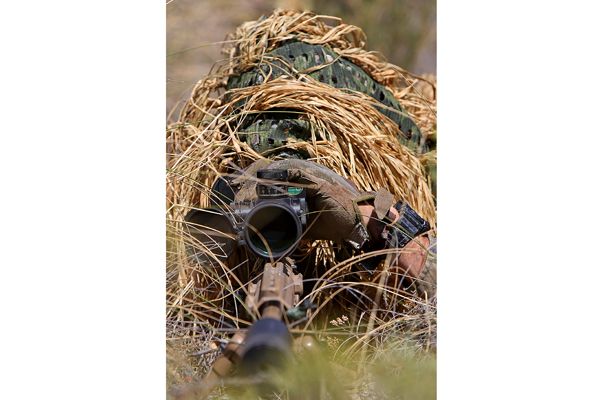- Home
- Feature Articles
- El intenso calor desafía la puntería
Intense heat challenges shooters’ aim
Tuesday, August 6, 2019
Number: 90
It wasn’t 40 years or the Sinai desert, but the participants in the 5th edition of Desert Sniper have also faced a tough test. Above all, they were challenged by the heat, but this was the idea behind taking them to the ‘Chinchilla’ Centre for Training (CENAD, to use it’s Spanish acronym) in Albacete, in the middle of July, the hottest and driest month of the year in this part of Spain.
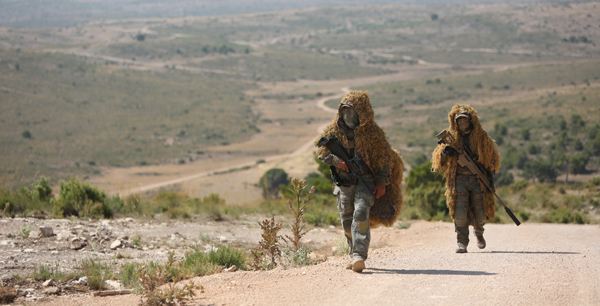
Those in charge of the workshops come from the International Special Training Centre which, five years ago, when they were looking for a desert and semi-desert environment in which to hold a course for select shooters, focused on Spain due to its climatology. As well as its hot and dry summer, another two factors led them to choose this location: on the one hand, CENAD’s possibilities for long range shooting, and on the other, the willingness of the Special Operations Command to bring about the collaboration. Sergeant Lendoz (from the United States Army), who is in charge of the training days, highlights this, assuring that working with the Special Operations Command and the Spanish Army “is very easy. I tell them what I want to do and they do everything they can; without their help there would be no Desert Sniper,” he affirms.
Technology has improved a lot, increasing the probability
of success on the first shot at greater distances.”
Master Sergeant G.M.S, Instructor
Three years since he took the reigns, Sergeant Lendoz has varied the activities, trying to get the most out of the two weeks which students from various European countries spend in Spain. They are already trained shooters and the majority have a lot of experience and have taken part in international missions given that this is advanced training and the exercises which it involves are highly demanding. The idea is “to give the shooters the opportunity to train in areas like this so that they can get used to conditions in desert or semi-desert areas,” he points out. Bearing in mind that some of the participants come from countries with quite cold climates, this opportunity is very interesting, because it is not the environment in which they usually operate. However, this scenario most closely resembles deployment zones, such as Iraq or Afghanistan.
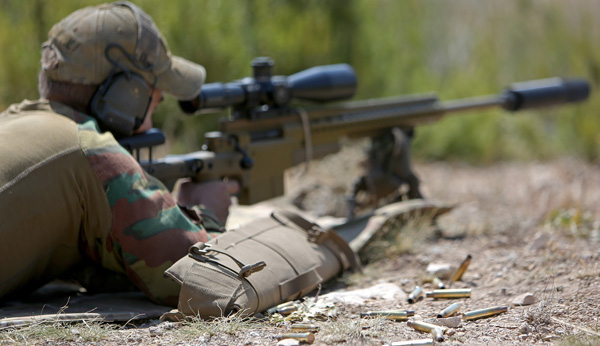
One of the ways to test how temperature affects shooting was to give them a bullet which had been refrigerated and another which had been in the sun. This way they could see the difference in how the projectile impacts when it’s hot and when it’s cold. This is another factor which must be kept in mind whilst doing the calculations for your shot, if you want to hit the target. This wasn’t always easy when the target was 1,500 metres away and the size of a head. “They are very difficult impacts,” recognises Master Sergeant G.M.S., from the 4th Special Operations Group. He was one of the nine instructors in this edition, and he participated as a guest, along with another Norwegian and an Italian. The other six were ISTC’s permanent teachers. “Long distance shooting with high temperatures is very complicated,” he insisted. The participants must be aware of these difficulties and “learn to know their limits, deciding if a shot is within their capabilities and explaining to their chief whether or not they can give the support they are demanding.”
"Almost all of the Special Operations Command shooters have
previously been in an operations team.
Because of this, we know what support they need.”
Staff Sergeant J.V.E, Group Chief
This is one of the most important lessons which the teachers hope the students take with them from the two training weeks. In this edition there were 27 students, amongst them Americans, Norwegians, Germans, Italians, Belgians and Spaniards. The Spaniards were guests, because Spain is not part of ISTC, although is is an associated country. All five Spaniards came from the Special Operations Command and were precision shooters trained in the Special Operations Shooter Training Centre (CATOE, to use its Spanish acronym). This centre, in which shooters from the Special Naval Warfare Force and the Paratrooper Sappers from the Air Force also train, instructs selected shooters in basic and advanced courses.

The CATOE managed all support, from the vehicles which were used to transport the equipment, to targets or target simulations and even the drivers to transport the staff. Furthermore, their two permanent instructors were there during the course of the activities in order to lend a hand, like Sergeant D.V.M.
As an experienced shooter, he is aware of the importance of knowing how to cope in different environments to avoid missing the shot, something which a select shooter cannot allow because “the lives of other comrades might depend on it.”
“I prefer the heat to the cold because I think it’s easier to fight it,
but it’s worse for shooting.”
Special Operations Shooter A.G.F.
He also knows that training a shooter takes time and a lot of dedication, something which Special Operations fighter J.C.N. is starting to realise: since he began his level 1 course in January, he hasn’t stopped. “Shortly after I finished level 1 I went on to level 2, which I finished a week ago, and now I’m here,” he says, referring to his time with the Desert Sniper operation. Above all, a real highlight of the experience was the opportunity to see how other armies work, something which the other participants also recognise. “This lets us see that there is no universal rule about how things are done. There are different ways of doing things and all of them are viable,” he adds.
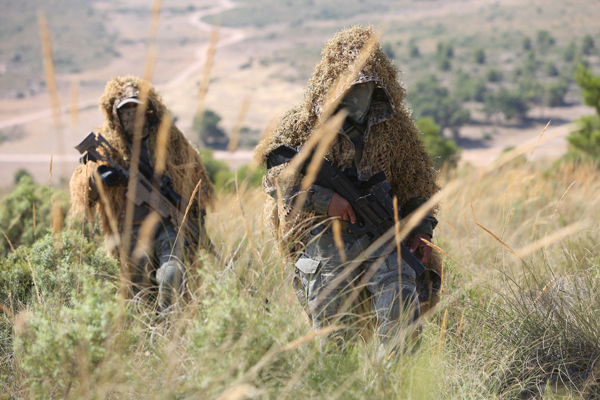
By comparing the procedures, Special Operations fighter A.G.F. concluded that the shooters from the Special Operations Command are “at the same level” as those from the other nations, and that “while they have nothing to be jealous of, they do have a lot to learn from the other participants. Those of us who have been doing this for less time need to focus on what the more experienced people are doing,” he stresses. However, in Staff Sergeant J.V.E.’s opinion there was one aspect in which the Spaniards had an advantage over the rest of the participants, especially those from colder countries: knowing the land. “For example, when it came to setting up shooting positions, we know the colour of the vegetation and how to put it up because it’s our land. We also had a certain advantage with the heat, because our bodies are more accustomed to it and we manage better with the heat shimmers and mirages,” he states. In this, the Spaniards have the home court advantage.
ISTC
Since 1979, the International Special Training Centre (ISTC) has offered advanced and specialized training for Special Operations Forces and similar units. Its objective is to increase the capacity and interoperability between the nine member nations – Germany, Belgium, Denmark, the United States, Greece, Italy, Norway, the Netherlands and Turkey – and with other allied nations and NATO.
WORKSHOPS
As well as Desert Sniper, the ISTC organises other workshops to help select shooters improve. Each workshop focuses on different aspects related to shooting.
• Combat marksmanship: an intense course to improve precision in stressful situations and at different ranges.
• Close combat: intermediate level, focusing on how to work as a team, in an urban zone.
• Precision shooting: provides the ability and knowledge to take action against objectives whilst using camouflage and concealment techniques.
• Angle shooting: this is done in the Austrian Alps in order to practice in a mountainous setting.
• Urban zones: this takes place in the American base in Germany and has a high performance urban zone shooting range.
THE CHALLENGES OF SHOOTING IN THE SUN
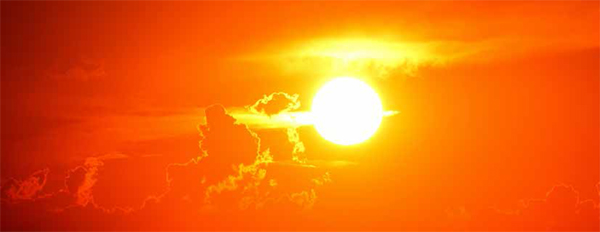
WIND
Wind is the enemy of all precision shooters, because it can blow in any season, whether the weather is cold or hot. It makes long distance shots particularly difficult because it can vary in speed and direction across the projectile’s trajectory. As Staff Sergeant J.V.E. warns, “in every valley the wind can come from one side”, which is a problem if the shooting position is slightly elevated.
MIRAGES
This optical phenomenon is caused by heat and distorts what we can see, making objects appear hazy. It is also called a heat shimmer. An experienced shooter, such as Special Operations fighter J.Z.G., who has spent two years in a shooters team from the Special Operations Command, already knows that mirages “usually make you aim higher because objects appear slightly more elevated than they actually are, so you need to lower your aim slightly.”
DEHYDRATION
It is important to drink water or liquids regularly in order to avoid dehydration or heatstroke.
SUNSTROKE
Teams of shooters may have to spend many hours in position, hardly moving, and they won’t always be able to find shade under which to hide themselves whilst the sun beats down. To combat over exposure to the sun it is important to have all body parts well covered, as opposed to taking off clothes, which many people tend to do. You only have to look at the Tuareg people, who really know the desert, to see this.
ARMY UNITS
- Araba Álava |
- Albacete |
- Alicante |
- Almería |
- Asturias |
- Ávila |
- Badajoz |
- Barcelona |
- Burgos |
- Cáceres |
- Cádiz |
- Cantabria |
- Castellón |
- Ceuta |
- Ciudad Real |
- Córdoba |
- A Coruña |
- Cuenca |
- Girona |
- Granada |
- Guadalajara |
- Gipuzkoa |
- Huelva |
- Huesca |
- Islas Baleares |
- Jaén |
- León |
- Lleida |
- Lugo |
- Madrid |
- Málaga |
- Melilla |
- Murcia |
- Navarra |
- Ourense |
- Palencia |
- Las Palmas |
- Pontevedra |
- La Rioja |
- Salamanca |
- Segovia |
- Sevilla |
- Soria |
- Tarragona |
- Santa Cruz de Tenerife |
- Teruel |
- Toledo |
- Valencia |
- Valladolid |
- Bizkaia |
- Zamora |
- Zaragoza



